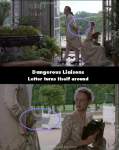Continuity mistake: At the end of the duel the Vicomte de Valmont falls where he is hit, next to the wall; Danceny and Azolan rush immediately to his side. During his subsequent repentance and death, he is not moved. In the final, overhead, shot of the scene there is a long trail of blood in the snow and Valmont is not near the wall. (01:49:30 - 01:52:30)
Continuity mistake: When Valmont visits Madame de Tourvel and enters her room, there's a servant standing next to Valmont who appears to leave and you hear the door close. In the next scene he is still standing there with the door closed and then takes Valmont's hat, opens the door, and leaves.

Continuity mistake: When Valmont is waving the letter behind his back, in the closeup the address is facing upwards, but in the wider shot we can see the wax seal is now visible.
Continuity mistake: When Valmont and Merteuil are at the party at the aunt's house, one of them takes a few steps away from the other while they're talking. In the next shot they're standing very close together.
Continuity mistake: When Glenn Close is convincing Madame de Volanges to take Cecile to the chateaux and Valmont is hiding in the other room eavesdropping, he is near the two women behind a screen, and then instantly appears across the room by the door where he ducks down rapidly to avoid being seen by Madame de Volanges.






Answer: He is probably a "castrato," a male soprano. Exceptionally talented choir boys were castrated before puberty to preserve their high voices. This pracitce lasted from the 16th century until the late 19th. The last castrato, Alessandro Moreschi, died in 1913. There are also some men who can naturally sing in this range, called countertenors.
raywest